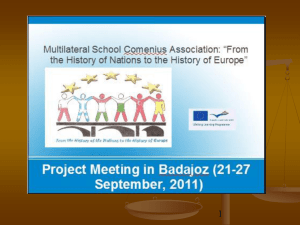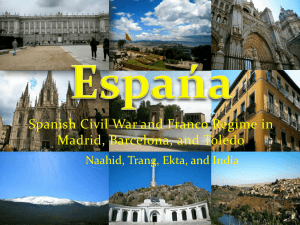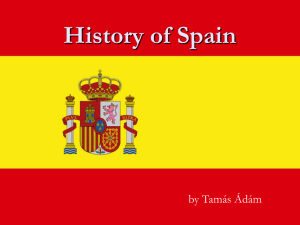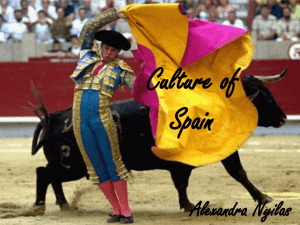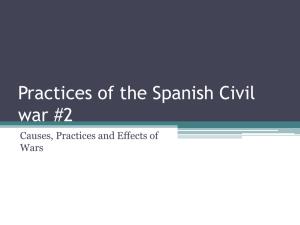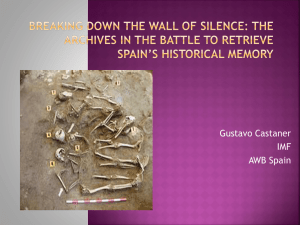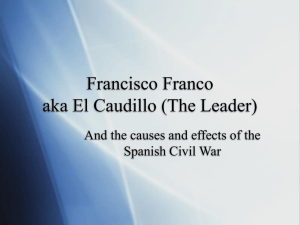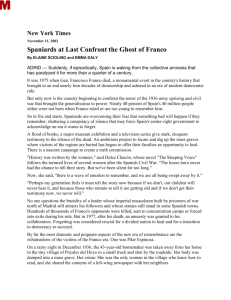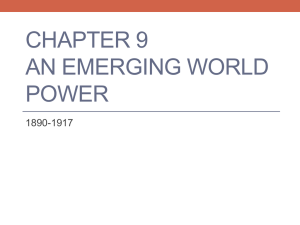La Movida Madrilena - 2013 Graduation ePortfolios BA in Spanish
advertisement
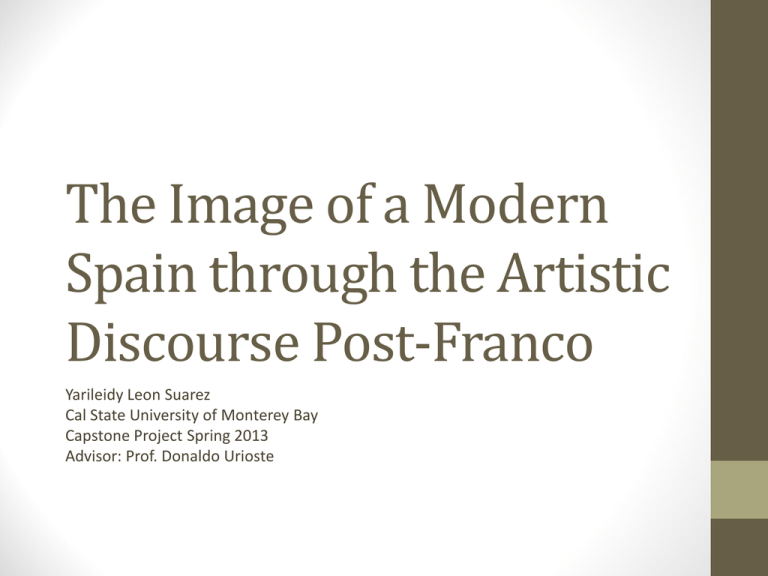
The Image of a Modern Spain through the Artistic Discourse Post-Franco Yarileidy Leon Suarez Cal State University of Monterey Bay Capstone Project Spring 2013 Advisor: Prof. Donaldo Urioste Abstract Spain suffered a dictatorship for almost 50 years under the totalitarian power of the General Francisco Franco. During this period, Spain was isolated cultural, economic, and politically from the rest of the world. After Franco’s death, Spanish people decided, unanimously, to stop another government of this type. A democratic government was an idea adopted by politicians and artists. The last group, especially, contributed, expanded, and created a New Spain. The image of a Modern Spain was the solution for rescuing a country and its idiosyncrasy after the silence and obscurity of Franco’s years. The objective of this project is to analyze how the artistic discourse during the period of transition to Democratic Spain create the image of a Modern Spain. Outline • • • • • • • • • Introduction Society and Art Art and Youth Dictatorship and Spain citizen Contemporary history of Spain 1936 -1993 Movida Madrileña “Madrid Scene” Pedro Almodovar Conclusion Bibliography Introduction • Common subjects about Spain Flamenco Pedro Almodovar Transcendental Spanish writer Federico Garcia Lorca Cities: Madrid, Barcelona, or Seville • Less common Civil War Franco’s dictatorship Transitional Period towards a Democratic Spain Society and Art “ The action of the situation’s subject provokes a change in the situation’s conditions to which situation it belongs to; such change at the same time varies the subject’s possibilities to react in the future.” Enrique Tierno Galván Sociedad y Situación. Murcia. Aula de Ideas. 1995. Translation by Yarileidy León Suarez • Artistic intellectual commitment with society. • Art and artistic discourse. • Movement of social art. Society and Art_ Commitment artistic intellectual with society Art: • Is a communicative process • Constructs sociocultural reality and a symbolic universe. • Reflects the every day life and its conflicts through form and figurative, epistemological, semantically, philosophical, semiotic language, etc. Society and Art_ Art and artistic discourse Art and artistic discourse concepts are polemic: • Change based on culture, time, and who produce and consume art. Examples of artistic discourse: • Format, shapes, colors, aesthetics. Society and Art_ Movement of social art • Necessary to fill the empty cultural environment in Spain after Franco. • Government supports and promotes social and artistic movements. • Slogans: “España está de rola” or “España está de moda”. Spain is fashionable and it is on the go. Art and Youth • Vanguard : The leading position in any movement or field, or the people who occupy such a position, e.g. the vanguard of modern literature. • Desire for Freedom: Young Spanish post Franco population restored the spirit of belonging, citizenship, nationalism, and modified the Spanish old traditions by introducing modern life style more alike the western European countries. Dictatorship and Spanish Citizen • Dictatorship not only establishes a totalitarian and repressive government; it also creates a social consciousness of fear and introspection • Franco’s Death: metamorphosis of Spain citizen • Social consciousness in relationship with freedom and determination • Globalization Contemporary History of Spain 1936-1993 • • • • • Spanish Civil War 1936-1939 General Francisco Franco’s dictatorship 1939-1975 Death of Franco, 1975 Transitional Period 1975-1993 Democratic Spain 1993 to Present Movida Madrileña_ Madrid Scene • Beginning • Significance • Precepts Movida Madrileña_ Beginning • 1977-1985 • In Madrid • Enrique Tierno Galvan, Madrid major supported the movement • Expanded other cities such as Bilbao, Vigo, Barcelona, and Seville Movida Madrileña_ Significance • Social stimulation • Fashion impulse • The “street” plays a protagonist role: space for free expression • Madrid becomes the hypocenter of entertainment culture and party scene • Music industry experienced an imminent growth: Mecano, Alaska, and other musical groups. Movida Madrileña_ Precepts • Movement based more on style than substance • Explosion of repressed feelings of freedom • Sexual liberation • Tolerance to alcohol and drugs • Disruption of the traditional and conventional Franco’s Spain • Spanish art opens up to postmodern technics and fundamentals: fetish and kitsch Pedro Almodovar • La Movida Madrileña • Social themes and his filmography Pedro Almodovar_ Movida Madrilena • Influence of Movida Madrilena • Death of Franco becomes a turning point for creation • Uses elements of Spanish picaresque novel such as antiheroic and antiepic tone characters • Founded EL DESEO film production S.A. and financed his own movies Pepi, Lucy, Bom y otras chicas del monton (1980). La Ley del Deseo (1987) Pedro Almodovar_ Social themes and filmography • Transgression: homosexually expose in mass media • Female characters disrupt the traditional image of patriarchal system • Destroy the image of family structure established by Franco Pedro Almodovar_ Social themes and filmography • Homosexuality • Nude • Kitsch • Taboo and trangressions Conclusion • As a mode of conclusion, the cultural transformation Spain experienced after Franco’s death, during the transitional period to Democratic Spain, created the foundations for the society we know today. This project has allowed me to learn more in-depth about Spanish society. I hope the same happened to you. Thanks for your attention, and keep enjoy the Capstone festival. Fototeca • • • • • • • • • • • • • • • • www.biography.com videotecaalternativa.ne cuabroad.cua.edu www.dailytelegraph.com.au www.fanpop.com www.demotix.com autoreprezentari.blogspot.com http://www.tumblr.com/tagged/cultura http://elpais.com/diario/2011/06/16/sociedad/ http://www.google.com/search?q=arte+social&client=safari&rls www.laguerracivil-4b.blogspot.com www.escuelalibredehistoriadores.wordpress.com http://historiauniversal.carpetapedagogica.com/2011/03/guerra-civil-espanola-1936-1939.html l72vaplm.wordpress.com federicokrampack.tumblr.com blogs.periodistadigital.com Bibliografía • • • • • • • • • • • • • Balibrea, Mari Paz. Tiempo de exilio. Una mirada crítica a la modernidad española desde el pensamiento republicano en el exilio. Barcelona: Montesinos, 2007. Bartolomé Martínez, Gregorio, et al. La lengua compañera de la transición política española: un estudio sobre el lenguaje del cambio democrático. Madrid: Frangua, 2006. Beriain, Josetxo e Ignancio Sanchez de la Yncera. Sagrado/Profano: Nuevos desafíos al proyecto de la modernidad. Bessière, Bernard. "La crisis cultural de la transición y el supuesto modelo francés" Actas del Congreso La cultura del otro: español en Francia, francés en España. Sevilla: APFUE, SHF, Departamento de Filología Francesa de la Universidad de Sevilla, 2006. Faulkner, Sally. A cinema of contradiction: Spanish Film in the 1960s. Fiol, NAxo. Aquí vale todo. Barcelona. Ed del autor. 1997. Lechado, Jose Manuel. La movida: crónica de los 80s. Mainer, José Carlos. "La cultura de la transición o la transición como cultura". Ed. Carme Molinero. La Transición, treinta años después. Barcelona: Península, 2006. 153- 171. Mingote Adan, José Carlos, Miguel Requena, Javier Alvarez Villa. El malestar de los jóvenes: contextos, raíces y experiencias. Molas, Joaquim. "La cultura catalana durante la transición". Ed. Carme Molinero. La Transición, treinta años después. Barcelona: Península, 2006. 173-183. Morán, Gregorio. El precio de la transición. Barcelona: Planeta, 1991 Pavlovic, Tatjana. Despotic bodies and the transgressive bodies: Spanish culture from Francisco Franco to Jesus Franco. Suny series in Latin American and Iberian thought and culture. SUNY Press, 2003. Perez-Sanchez, Gema. Queer transitions in Contemporary Spanish culture: From Franco to La movida


